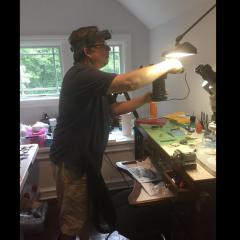Valjoux 72c Minute Recording Jumper/Pawl
-
Recently Browsing
- No registered users viewing this page.
-
Topics
-
Posts
-
Hi my fellow forum addicts, I'm writing this as I seem to have a hole in my knowledge (probably one of many!) I seem to have a horrible time removing bezels from watches. I am talking about the rotating type on sports/diving watches. I see many videos where the guy on screen barely inserts the case knife under the bezel and with no effort it pops off easily, then at the end it clicks back into place by hand with no effort. I am sure that part of this is due to skillful video editing, but I seem to wrestle with them, I have tried case knives and even when using the tool below, I tighten it up in several positions and nothing happens. On a many occasions I have even warped the bezel in my attempts to remove it. Similarly, I have issues replacing bezels after cleaning etc. and often they have to be replaced using a press tool and inevitably are far too tight and will not rotate or loose to the point where they fall off or loose their click (perhaps due to micro warping when I tried to remove??). It is now to the point where I am actually avoiding watches with bezels as my success rate with them is terrible......please help!! In short I am asking: What am I doing wrong? What is the best method for removing bezels - how do you do it? What is the best method for replacing bezels - how do you do it? Any tips or tricks? Thanks
-
By ManSkirtBrew · Posted
Amplitude still seems low, but I'm going to let it run in a bit and revisit. Meanwhile, got the first layer of the calendar works together and made sure the date ring snaps to both in quickset and regular setting. The mechanism is pretty cool, so I took a video. -
By HouseofGeorge · Posted
Hi wathweasol. I think it's made of brass. From the look of things, replacing the whole pusher as a set is beginning to be the way to go. Thanks. I'm thinking it could be just a tube and friction fit. I've taken another shot of the tube and posted here. Looks like just a tube fitted flush. Then, again, I have no experience in chronographs especially tubes and pushers. This one has no clips or washers to lock in the pusher in place. Coming from the outside, you'll have the button, spring and the stem inserted from the case and screwed in. The case holds the spring in place and the ridge at the other end of the stem keeps it from falling out of the case. Posted some pics here and an illustration to help. My sketch of how all the parts come in to play: Two different angles of the stem. Note the ridge near the slotted end that stops it falling out. This is an assembled piece of the one that was successfully pulled out. If it will have to be replaced, may I have some tips please on how to place an order, sizing, etc (Cousins, Esslinger,...) and on how to remove/install the pushers. My experience is just basic service with time only, day/date complications. Haven't had the opportunity to replace crown tubes and pushers. Thank you so much. -
If you have no Powerpoint at Hand (but Libre-Office or whatever..), to get Access to the Videos in the pptx, make a Copy of the File, rename it to blabla.zip and unzip the File. Now in the Folder ppt/media you have all Pictures and Videos...... hope this helps some of us regards, Ernst
-






Recommended Posts